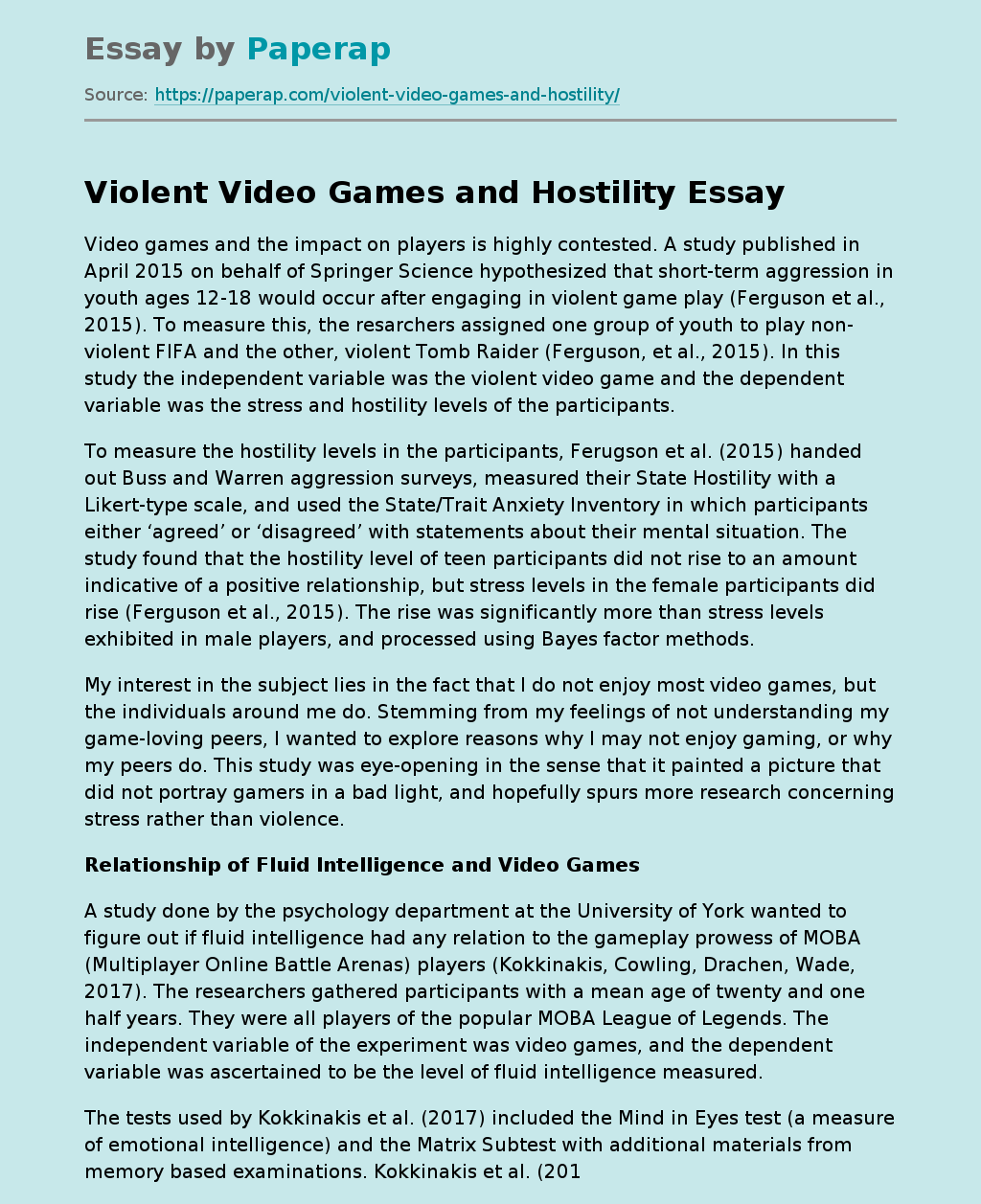Violent Video Games and Hostility
Video games and the impact on players is highly contested. A study published in April 2015 on behalf of Springer Science hypothesized that short-term aggression in youth ages 12-18 would occur after engaging in violent game play (Ferguson et al.
, 2015). To measure this, the resarchers assigned one group of youth to play non-violent FIFA and the other, violent Tomb Raider (Ferguson, et al., 2015). In this study the independent variable was the violent video game and the dependent variable was the stress and hostility levels of the participants.
To measure the hostility levels in the participants, Ferugson et al. (2015) handed out Buss and Warren aggression surveys, measured their State Hostility with a Likert-type scale, and used the State/Trait Anxiety Inventory in which participants either ‘agreed’ or ‘disagreed’ with statements about their mental situation. The study found that the hostility level of teen participants did not rise to an amount indicative of a positive relationship, but stress levels in the female participants did rise (Ferguson et al., 2015). The rise was significantly more than stress levels exhibited in male players, and processed using Bayes factor methods.
My interest in the subject lies in the fact that I do not enjoy most video games, but the individuals around me do. Stemming from my feelings of not understanding my game-loving peers, I wanted to explore reasons why I may not enjoy gaming, or why my peers do. This study was eye-opening in the sense that it painted a picture that did not portray gamers in a bad light, and hopefully spurs more research concerning stress rather than violence.
Relationship of Fluid Intelligence and Video Games
A study done by the psychology department at the University of York wanted to figure out if fluid intelligence had any relation to the gameplay prowess of MOBA (Multiplayer Online Battle Arenas) players (Kokkinakis, Cowling, Drachen, Wade, 2017). The researchers gathered participants with a mean age of twenty and one half years. They were all players of the popular MOBA League of Legends. The independent variable of the experiment was video games, and the dependent variable was ascertained to be the level of fluid intelligence measured.
The tests used by Kokkinakis et al. (2017) included the Mind in Eyes test (a measure of emotional intelligence) and the Matrix Subtest with additional materials from memory based examinations. Kokkinakis et al. (2017) did find that the WASI II Matrix Test posed significant levels of correlation to fluid intelligence and the rank of the players. However, memory and emotional intelligence proved to have weak correlation to rank and gameplay.
The most important finding from the study was that players of ‘first person shooters’ or MOBAs may experience better visuospatial processing performance, but lower levels of emotional intelligence or even reduction of cortical matter in the brain (Kokkinakis et al. 2017). It was also found by Kokkinakis et al. (2017) that the rank of the League of Legends player had a correlation with fluid intelligence levels.
My interest in the subject was prompted by conversations between myself and friends. We had differing opinions on the effects of video games on how you perform socially or on tests. While I have certain friends who insisted that video games are beneficial to not only your mental health, but coordination and reflexes, I was of the opinion that video games would either have negative or little effect on coordination, reflexes, or mental well-being.
Television Exposure and Executive Function Among Preschoolers
A study at Ohio State University sought to examine the relationship between executive function in preschoolers and the television they watched (Nathanson, Alade, Sharp, Rasmussen, Christy, 2014). The hypothesis of the study was that there was a significant relationship between poor executive function development and exposure to television. In this study, the independent variable was the television viewing habits, and the dependent variable was the executive function skills shown by the toddlers.
The procedure included a mixture of reports by parents about their children’s viewing habits and interactive tasks performed by the participants with researchers. Parental reports included the number of hours spent watching television, the age at which their child started viewing television, the genre of the programs watched by children, and the frequency they watched different channels. The executive function of the participants was measured in four tasks that involved repetition of words, placement of objects, turn-taking or sharing with experimenters, and speech (Nathanson et al., 2014).
Nathanson et al. (2014) found that executive function and television exposure among preschoolers did have a negative relationship in which the EF was impaired by the television. Kids who viewed more television than others would have the poorest executive function skills. Additionally, it was found that the age of television viewing onset and number of hours spent viewing were strong predictors for negative executive functioning skills (Nathanson et al., 2017).
My interest in the subject comes from my belief that what children view deeply impacts them. I wanted to apply my understanding of how media affects social atmosphere to a younger age group than my own. I think this is especially important as new technology emerges.
Violent Video Games and Hostility. (2021, Dec 14). Retrieved from https://paperap.com/violent-video-games-and-hostility/

